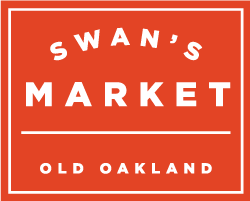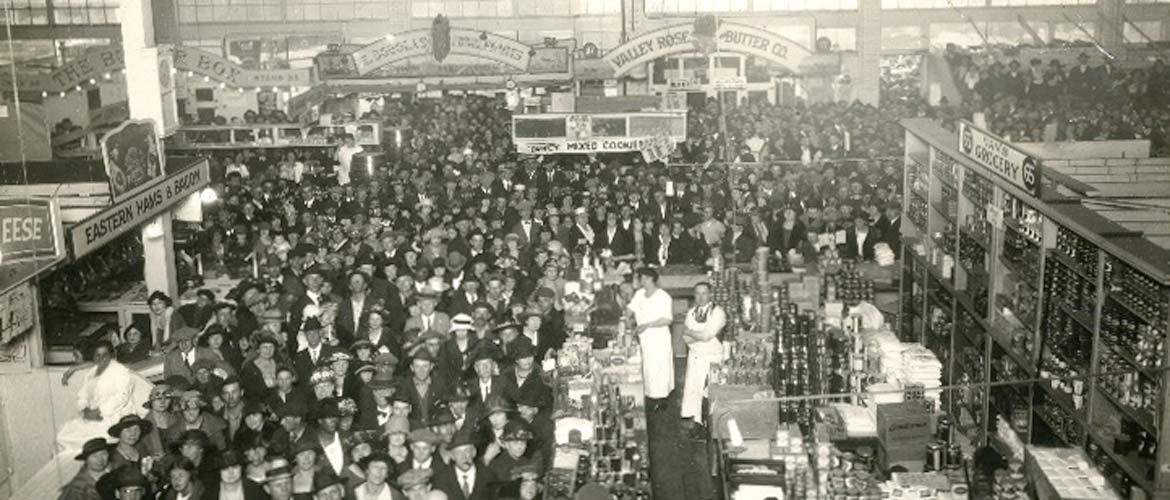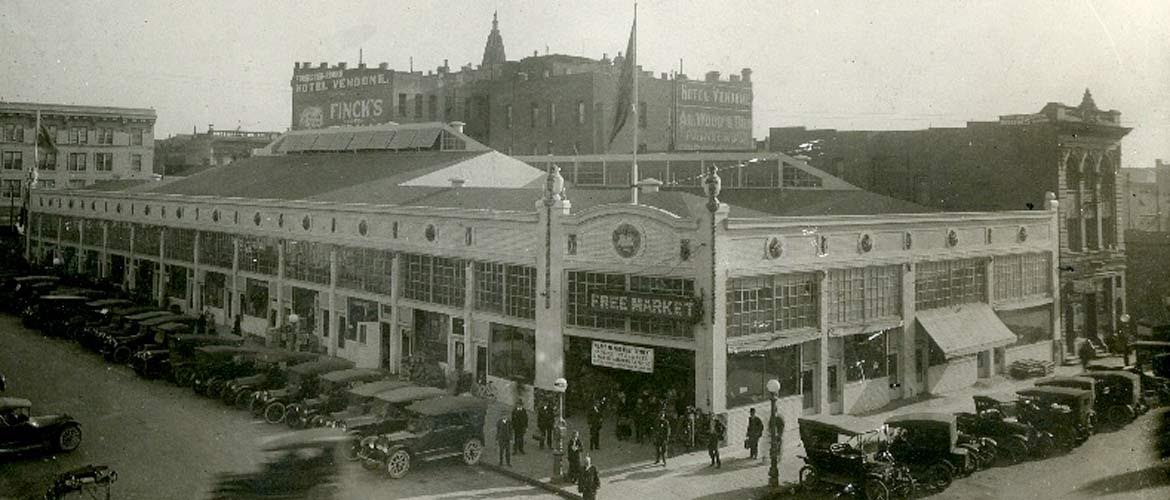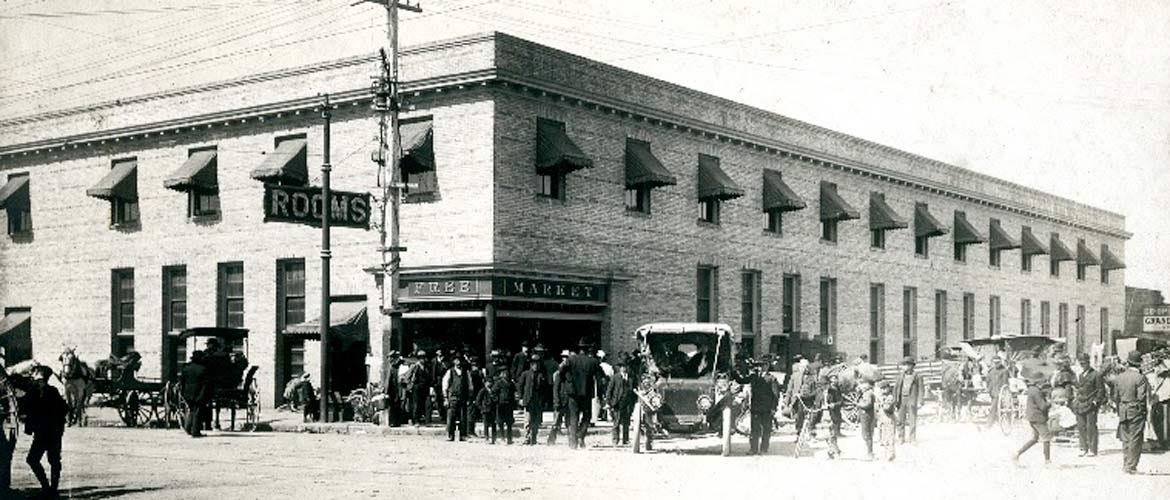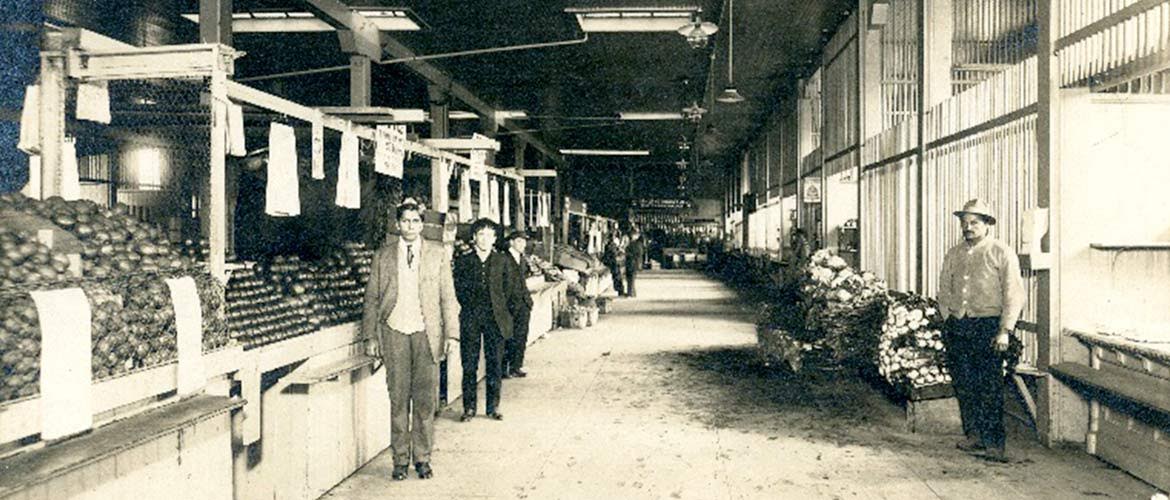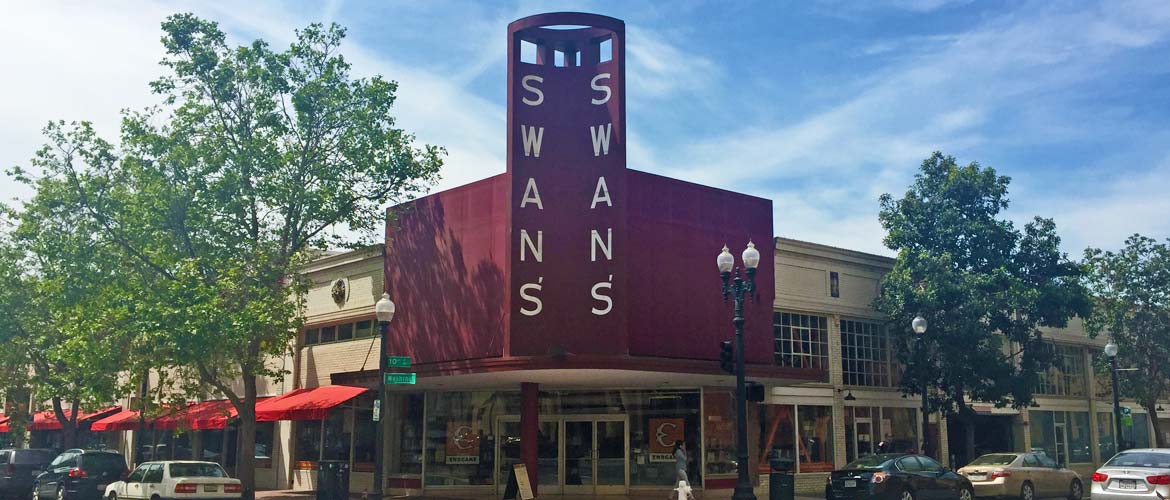Introduction
Swan’s Market was acquired by the East Bay Asian Local Development Corporation (EBALDC) in 1998 and the initial historic restoration was completed in 2000. The original Swan’s Marketplace opened in 1917 and served as downtown Oakland’s premier market until its closure in 1983. The site then stood vacant until EBALDC’s award-winning redevelopment provided affordable rental housing and market rate “cohousing” condominiums with a variety of businesses. EBALDC’s goal for the renovation was to convert a blighted block into a community gathering place that included residents of both low-income and market-rate housing, small businesses and non-profits to establish a blend of artistic, cultural and culinary traditions to serve Oakland’s diverse Downtown. Today, Swan’s Market is a popular destination in Oakland and is home to some of the City’s most popular restaurants.
History
The central depot for the first railroad linking California to the eastern states arrived in Oakland on November 8, 1869 at Broadway and 7th Street. Hotels, restaurants, barber shops, drug stores and other services for travelers sprang up in the surrounding streets, and (what we now refer to as ‘Old Oakland’) became one of the most dynamic and diverse neighborhoods in Oakland. Among these businesses was the founding of the ‘Oakland Free Market’ in 1890 (which was just four blocks away on Clay Street between Fourth and Fifth Streets from 1890 to 1910), the predecessor of today’s Swan’s Market.
Read more »»The building on 9th Street (between Clay & Washington) has a long history of retail and mixed use, dating back to the relocation and construction of the Oakland Free Market in 1917. The original proprietor, Jacob Pantosky, was a self-described poultry dealer, broker, speculator, junk dealer, shoe merchant and hotel manager. In a sense, Pantosky’s career established a consistent mixed-use theme for the history of what is now known as Swan’s Marketplace. As late as 1981, Swan’s was listed in the Oakland phone book variously as “department store,” “drug store” and “food store.”
During World War II, when many African Americans migrated from the south to work in the war industries, Swan’s was a gathering place where people would go to reconnect with friends and family who had also moved to the area.
Over 150 years later, the market still maintains its sense of history and has been returned to a modernized version of its’ former glory as a place to meet and “break bread.” It is also showcase for small, local businesses with some of the best food and wine in the Bay Area.
A Downtown Neighborhood in Decline
From the 1950s until the late 1990’s, Oakland’s downtown district was in decline. The broad trend of suburbanization combined with the local urban renewal program contributed to the depopulation of Oakland. As the center declined, so did commercial traffic at the market and maintenance of the facility. Customers were cut off from the market in the late ‘60s and early 70’s when the neighbourhood was cut off on all four sides by the combination of BART construction, which tore up Broadway; the new convention center, which closed Washington Street; and freeway construction. With all of the surrounding construction, it is remarkable that Swan’s Market survived until it finally closed in 1984. By the 1990s, the neighborhood surrounding the Swan’s block was physically isolated and largely abandoned by viable businesses. Only the Housewives Market, which was a collection of vendors supported by the Oakland Redevelopment Agency, survived. The Housewives Market eventually relocated into Swan’s. Taylor’s Sausage and Sincere Fish are the last two remaining businesses from the Housewives Market.
A Downtown Neighborhood Coming Back
In 1989, after the Loma Prieta earthquake and following five years of vacancy, three blocks of Old Oakland, including Swan’s Marketplace, were sold by the Oakland Redevelopment Agency (ORA). Although EBALDC had proposed mixed income housing on two blocks and retail on the Swan’s block, the city sold the other two blocks to private developers and asked EBALDC to pursue an adaptive re-use of the historic structure as a mixed-use complex. This complete market renovation was completed in 2000 and listed on the National Register of Historic Places.
By the time of the Great Recession, many of the original Housewive’s Market merchants had closed, so EBALDC used an innovative financing tool to revitalize the retail space. Using federal tax credits for assisting small businesses, EBALDC worked with a group of small, local restaurateurs to build on Swan’s tradition of being a multi-cultural meeting place that reflects the diversity of our community. Starting in 2012, Cosecha joined the existing market food shops, Taylor’s Sausages and Sincere Seafood. Other vacancies were filled by Rosamunde Sausages, Periscope Cellars Winery and Miss Ollie’s. B-Dama and The Cook & Her Farmer joined the market in 2014.
Read less »»Architecture
For 60 years following Pantosky’s 1917 commission to the Oakland architectural firm of Oliver and Thomas, the multiple buildings on the Swan’s block were among the most important shopping destinations in Oakland. Washington Street was the premier retail street in downtown, running a full 14 blocks from the waterfront to City Hall at Fourteenth Street. Swan’s Marketplace was its centerpiece.
Read more »»Subsequent construction on the Swan’s block reinforced its importance and attracted increasingly prestigious tenants and architects. The Historic Resources Inventory of the block identifies a 1921 addition at 910 Clay Street by architect A.W. Smith, and three more additions by William Knowles between 1925 and 1927. In 1940, the block was filled out at the corner of Ninth and Washington Streets with what became the Swan’s Department Store by the architect, Edward T. Foulkes. Foulkes also designed other significant structures in Oakland, including the Elks Building on Broadway and the Roos Brothers Tribune Tower. Smith, Knowles, Foulkes and others who worked on the Swan’s block helped sustain Oliver and Thomas’ original design with the use of white glazed brick and multi-colored terra cotta medallions. The consistent use of these materials, the structural module, and the window treatments helped give the block a unified appearance over 23 years of building additions.
Architect Michael Pyatok’s design for Swan’s Marketplace has continued the tradition of respecting the original architecture. The renovated structure is now listed on the National Register of Historic Places and won the 2001 Rudy Bruner Silver Medal Award for Excellence in Urban Design.
Read less »»Chronology
1890 – Oakland Free Market established near the site.
1907 – Housewives Market opens near the site.
1917 – Jacob Pantosky constructs new building on present location; Oakland Free Market relocated.
Read more »»1940 – Largest addition added to the block’s southeast corner and renamed Swan’s Tenth Street Market.
1960-1984 – Construction of Interstates 880 and 980, convention center, police station and BART cuts off Old Oakland from the rest of the City; and magnifies disinvestment in the area that results from suburbanization. Nine thousand housing units demolished by redevelopment in downtown.
1984 – Swan’s Market closes.
1989 – Loma Prieta earthquake; Swan’s block and two others on Clay Street, including the Housewives Market, purchased by the Oakland Redevelopment Agency (ORA).
1994 – ORA issues request for proposals for market-rate housing on three blocks including the Swan’s block.
1996 – East Bay Asian Local Development Corporation (EBALDC) selected by the ORA and City Council to develop the Swan’s Marketplace block.
1998 – Ground breaking of Historic Preservation and adaptive reuse of site designed by Pyatok Associates, with Housewives Market design by Y.H. Lee Associates.
2000 – Swan’s Marketplace completed with Housewive’s Market relocated to Swan’s.
2012 – EBALDC adds local restaurants that reflect the diversity of Oakland and adds a community garden to the courtyard.
Read less »»